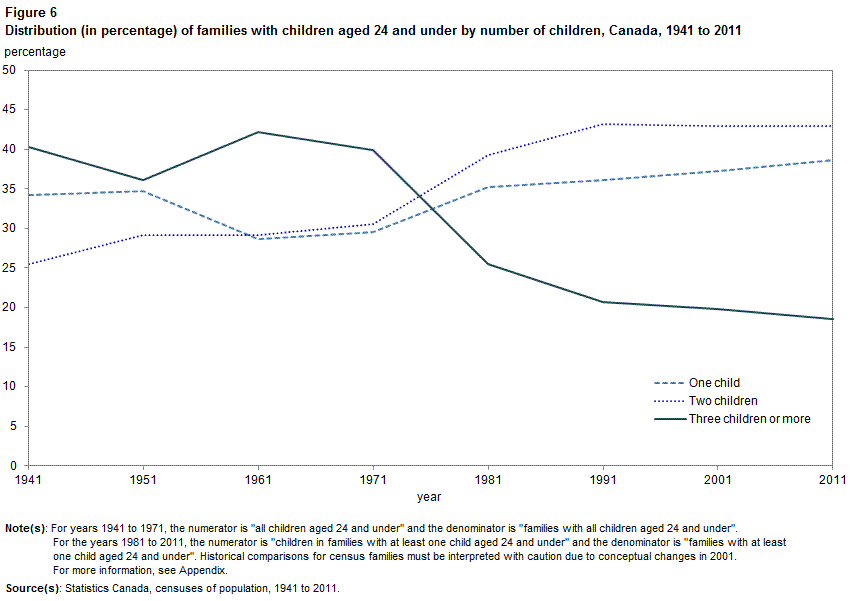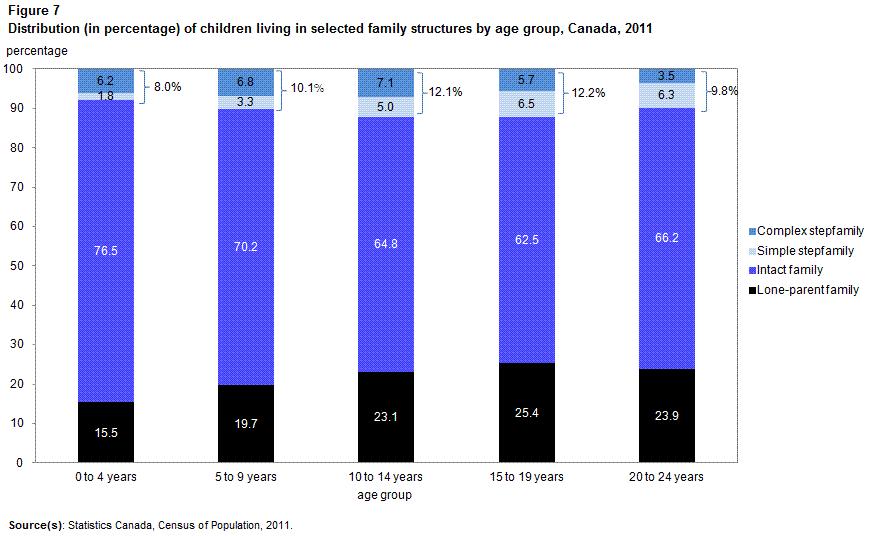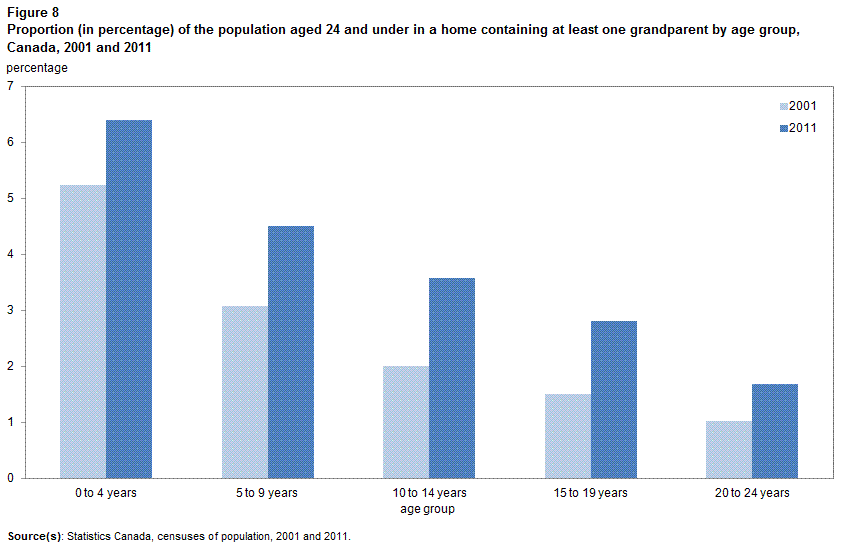Publications
Demographic Documents
Enduring Diversity: Living Arrangements of Children in Canada over 100 Years of the Census
The 21st century to date
Archived Content
Information identified as archived is provided for reference, research or recordkeeping purposes. It is not subject to the Government of Canada Web Standards and has not been altered or updated since it was archived. Please "contact us" to request a format other than those available.
The current century has witnessed a continuation of many societal changes begun in the preceding one, which in turn have influenced the living arrangements of children and young adults. Among these continuing family-related patterns is a longer transition to adulthood for many young people; as evidenced by the trends of delayed union formation, older ages at childbearing, and a higher tendency to remain in, or return to, the parental home (Box 4).Note 34
While the majority of children (64.9%) continue to live with married parents, the shares living with common-law parents or a lone parent have grown. Between 1981 and 2011, the proportion of children who were living with common-law parents grew more than five times, from 2.6% in 1981 to 13.7% in 2011. This trend was particularly prevalent in the province of Quebec and Nunavut territory, where 31.6% and 32.6% of children lived with common-law parents in 2011, respectively. Yet, for Canada as a whole, there were still proportionally more children living with a lone parent (21.5%) than with common-law parents. Indeed, the share of children living with a lone parent in 2011 is the highest ever recorded, and more than triple that observed at the height of the baby boom (6.4% in 1961).
The characteristics of lone parents have also continued to evolve. In the decades since 1981, shared custody of children following the breakup of a union has become more common. Reflecting this trend, the proportion of children in lone-parent families living with a male lone parent has reversed its formerly declining trend, increasing from 15.5% in 1996 to 20.1% in 2011.Note 35 While the majority of children in lone-parent families now live with a parent who is divorced, separated or married (spouse absent), the share who live with a single never-married parent has more than quadrupled over the past 30 years, from 9.0% in 1981 to 37.4% in 2011.Note 36
Social, cultural and economic changes following the baby boom resulted in a decline in the average number of children per family, and in turn, the number of siblings with whom children tend to grow up. The total fertility rate was 1.61 children per woman in 2011, less than half that observed at the peak of the baby boom (3.94 children per woman in 1959).Note 37 Along with this trend came a sizeable reduction in the average household size, from 3.9 persons in 1961 to 2.5 persons in 2011.Note 38 In 1961, families with children were most likely to have three or more children at home (42.2%). By 2011, this was the case for less than 2 in 10 families with children (18.5%) while it was more likely that families had two children (42.9%) or one child (38.6%) at home (Figure 6).

As a result of smaller family sizes, individuals aged 24 and under represent a relatively small proportion of the total population—29.8% in 2011—and increasing focus is being placed on the constantly-growing senior population. It is estimated that the number of people aged 65 and over could surpass the number aged 14 and under by 2021. By 2036, people aged 24 and under could represent 27.5% of the total Canadian population, about half of their share in 1901 (54.3%) and just slightly above the projected proportion of seniors (23.7%).Note 39
Reflecting the trends of delayed childbearing and the aging of the population, many couples in the new millennium do not have children at home, either because they have never had children or because their children have grown and moved out of the parental home. The 2006 Census marked the first time that there were more couples without children aged 24 and under (42.7% of all census families) than couples with children aged 24 and under (41.4%), a pattern that continued in 2011.Note 40 Moreover, for the first time, in 2011 there were proportionally more one-person households (27.6%) than households comprised of couples with children (26.5%).Note 41
The 21st century has to date seen a growing societal recognition of other family forms, as evidenced by the legalization of same-sex marriage across Canada in 2005. Beginning in 2001, children living with two parents could be distinguished as living with either opposite-sex or same-sex parents in the census.Note 42 Of the 8.8 million children aged 24 and under who lived with two parents in 2011, the majority (99.9%) lived with opposite-sex parents while the remaining 9,600 children lived with same-sex parents. While relatively small, this number is more than double that observed in 2001 (4,600). More than four times as many children lived with female same-sex parents (7,700) in 2011 as with male same-sex parents (1,900), while the number living with same-sex married parents was slightly less than those living with same-sex common-law parents (4,000 and 5,500, respectively).
As seen earlier, diverse family structures such as stepfamilies have always been present to some degree, although it was not until 2011 that information on their precise characteristics became available in the census. Beginning in 2011, children living with two parents could be classified as living in either an intact family or a stepfamily. Most commonly, children lived with two parents in an intact family—a couple family in which all children are the biological and/or adopted children of both members of the couple. However, 929,600 children, or 10.5% of all children, lived in stepfamilies in 2011—couple families in which at least one child is the biological or adopted child of only one married spouse or common-law partner. Figure 7 shows that the proportion of children who lived in stepfamilies in 2011 varied with age, being highest for those aged 10 to 14 and 15 to 19 (12.1% and 12.2%, respectively) and lowest for those aged 0 to 4 (8.0%).

Stepfamilies can be further distinguished as simple or complex (see Appendix for details). Of all age groups, children aged 15 to 19 were the most likely to live in a simple stepfamily (6.5%) in 2011, meaning that all of the children in the family were the biological or adopted children of only one married spouse or common-law partner in the couple. Children aged 10 to 14 were the most likely of any age group to live in a complex stepfamily (7.1%), meaning that they lived with at least one half sibling or stepsibling.
Children in stepfamilies, as well as their parents, may be considered “pioneers exploring unchartered territory in the world of family relationships”Note 43 given that there is greater uncertainty in the roles and responsibilities of stepfamily members. While for many children, having stepparents and/or stepsiblings may be a positive experience, there is some evidence that children raised in stepfamilies, as well as those raised by lone parents, experience disadvantaged socio-economic outcomes compared to children raised in intact families.Note 44
The previous examination of the early 20th century showed that many children lived with a grandparent for some period of time who was, in some cases, the sole guardian of the child and in others one of several extended family members present in the household. A century later, information on children living with grandparents once again became available in the census. In 2011, 366,800 children aged 24 and under lived in homes containing at least one grandparent, either with or without their parent(s) present. This represented 3.7% of all children in this age group, up from 2.5% a decade earlier. This trend has occurred alongside an increase in the proportion of multiple-family households, which may partly reflect changing economic circumstances and/or cultural preferences of families and family members, among other possible reasons.Note 45 The proportion of children in homes with at least one grandparent in 2011 generally was highest among very young children, representing the situation of 6.4% of children aged 0 to 4 in 2011 compared to 1.7% of those aged 20 to 24 (Figure 8).

As these more detailed and varied concepts of family structure continue to be measured, future censuses will reveal how the relative prevalence of children living in same-sex couple families, stepfamilies and multi-generational families will evolve over time. Combined with the trends regarding married, common-law and lone-parent families, the new millennium to date has been a time of considerable growth in the diveristy—and measurement—of children’s living arrangements.
Notes
- For more information, see Clark, W. 2007. “Delayed transitions of young adults”, Canadian Social Trends, Statistics Canada Catalogue no. 11-008.
- Less sole custody awarded to mothers following divorce and more joint custody increases the chance of a father having custody of a child on Census Day. As measured by the census, lone-parent families may not fully capture the complexity of children’s living arrangements and custodial circumstances.
- This increase is in small part due to a concept change in 2001 regarding census families. For more information, see Appendix.
- Milan, A. 2013. “Fertility: Overview, 2009 to 2011”, Report on the Demographic Situation in Canada, Statistics Canada Catalogue no. 91-209-X.
- 2011 Census of Population and Wargon, S.T. 1979. Canadian Households and Families, Statistics Canada Catalogue no. 97-753, Table 2.1.A.
- Projection based on the 2006 Census and according to the medium-growth (M1) scenario. Source: Population Projections for Canada, Provinces and Territories 2009 to 2036, Statistics Canada Catalogue no. 91-520-X.
- Milan, A. and N. Bohnert. 2012. Portrait of Families and Living Arrangements in Canada, Statistics Canada Catalogue no. 93-312-X-2011001.
- Milan, A. and N. Bohnert. 2012. "Canadian households in 2011: Type and growth", Census in Brief, Statistics Canada Catalogue no. 98-312-X-2011003.
- Data on same-sex common-law couple families was made available in 2001, while in 2006 this was expanded to include same-sex married couple families following legislative changes in 2005.
- Juby, H. 2003/2004. “Yours, Mine, and Ours: New Boundaries for the Modern Stepfamily”, Transition, The Vanier Institute of the Family.
- Kerr, D. and R. Beaujot. 2003. “Family relations, low income and child outcomes; a comparison of Canadian children in intact, step and lone-parent families”, International Journal of Comparative Sociology, volume 43(1), pages 134 to 152.
- Milan, A. and N. Bohnert. 2012. “Canadian households in 2011: Type and growth”, Census in Brief, Statistics Canada Catalogue no. 98-312-X-2011003.
- Date modified:
